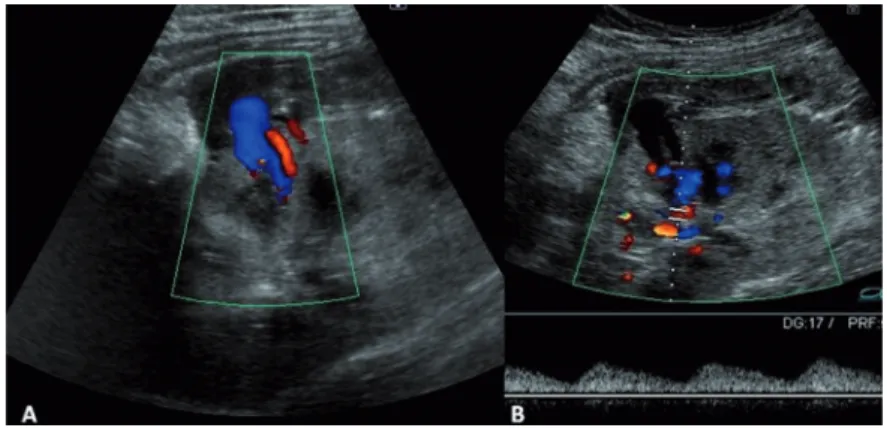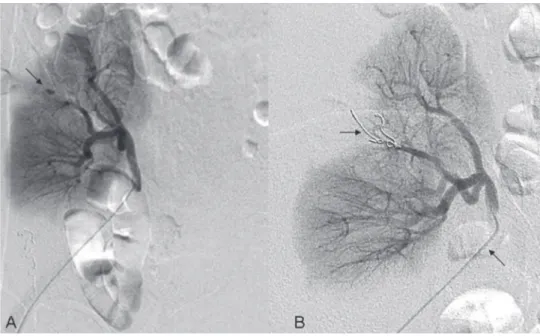Renal pseudoaneurysm after core-needle biopsy of
renal allograft successfully managed with superselective
embolization
_______________________________________________
Ioannis M. Antonopoulos
1, Kleiton Gabriel Ribeiro Yamaçake
1, Bruno C. Tiseo
1, Francisco C. Carnevale
1,
Enio Z. Junior
1, William C. Nahas
11 Divisão de Urologia, Hospital das Clinicas, Universidade de São Paulo, São Paulo, SP, Brasil
______________________________________________________________________________________
165
RADIOLOGY PAGE
INTRODUCTION
Renal biopsy of the allograft is important to evaluate renal dysfunction (1). Rare compli-cations like pseudoaneurysm (PA) can develop and could lead to life-threatening bleeding (2, 3). It can be safely and effectively managed by endovascular embolization yielding good renal function in the long term follow-up (4, 5). We describe a PA of a kidney transplant (KTX) asso-ciated with arteriovenous fistula (AVF) at the site of a core needle percutaneous biopsy (CNPB).
CASE DESCRIPTION
A 39-year old woman with nephrosclero-sis and in hemodialynephrosclero-sis for the last 3 years
re-ceived a KTX from a deceased 20-year old male donor that had a cranio-cerebral trauma. The vascular anastomoses were performed at the ri-ght iliac vessels in an end-to-side fashion after 23 hours of cold ischemia.
A CNPB, guided by ultrasonography, was indicated due to delayed graft function at postoperative day 10 which revealed acute tubular necrosis. Shortly after the CNPB she experienced tachycardia, hypotension and de-creased blood levels requiring 2 units of blood transfusion and remained stable and developed mild hematuria. An allograft ultrasonography performed five days later revealed an AVF and a PA at the middle pole of the allograft and a peri-renal hematoma around the upper pole with 200cc (Figure-1). A superselective
cathe-Figure 1 - A-Doppler ultrasound with reverse diastole in interlobular artery and lesion suggestive of pseudoaneurysm at the middle pole of the kidney. Cystic formation which implies the renal parenchyma toward the collection, that measured about 1.2cm. This structure has bidirectional blood flow, suggestive of a pseudoaneurysm. B–Pulsatile flow in the vein suggestive of AVF.
IBJU| RADIOLOGY PAGE
166
terization was then performed, six days after the CNPB with embolization of the PA with two coils. AVF was not observed (Figures 2 and 3). A control by ultrassound 5 days after the
pro-Figure 3 - Superselective catheterization of the interlobular artery.
Figure 4 - Doppler control demonstrating the closure of the PA. Figure 2 - Renal transplanted arteriography: (A)-Sacular formation in the arterial phase of the study, suggestive of pseudoaneurysm (Arrow), (B)-a microcatheter (inferior arrow) has been advanced superselectively in the lesion arterial branch with Vortex coil (superior arrow).
IBJU| RADIOLOGY PAGE
167
ARTICLE INFO
Int Braz J Urol. 2016; 42: 165-7
_____________________
Submitted for publication: April 23, 2014
_____________________
Accepted after revision: July 27, 2015
REFERENCES
1. Dimitroulis D, Bokos J, Zavos G, Nikiteas N, Karidis NP, Katsaronis P, et al. Vascular complications in renal transplantation: a single-center experience in 1367 renal transplantations and review of the literature. Transplant Proc. 2009;41:1609-14.
2. Selim M, Goldstein MJ. Case report: parenchymal pseudoaneurysm of a renal allograft after core needle biopsy: a
_______________________ Correspondence address: Kleiton G. R. Yamaçake, MD
Unidade de Transplante Renal do Departamento de Neurologia da Universidade de São Paulo (USP)
Av. Dr. Enéas de Carvalho Aguiar 255, 7º andar - Sala 710F Cerqueira César - São Paulo – SP, 05403-000, Brasil Telefone: 55-11-2661-8080
Fax: 55-11-2661-8081
E mail: kleiton_med91@yahoo.com.br
CONFLICT OF INTEREST
None declared.
rare cause of allograft injury. Transplant Proc. 2011;43:2781-3. 3. Klop KW, Karatepe O, Weening JJ, van Agteren M, Dor
FJ. Ruptured pseudoaneurysm in a renal allograft after percutaneous biopsy. Kidney Int. 2012;81:420.
4. Maleux G, Messiaen T, Stockx L, Vanrenterghem Y, Wilms G. Transcatheter embolization of biopsy-related vascular injuries in renal allografts. Long-term technical, clinical and biochemical results. Acta Radiol. 2003;44:13-7.

